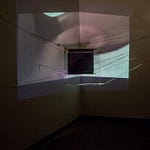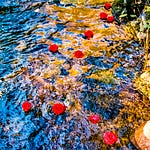Making Sense, is something humans are kinaesthetically made to do. So when it comes to the ways those senses work, how much trial and error is required to establish relationships between subjectivity and objectivity?
As a thought experiment, how to establish intelligence? How does rationality and irrationality draw lines of tolerance and intolerance? These are the kind of questions I dove into during the independent studies Annetta Kapon mentored me through while completing a master in art. What befuddles me to this day, is the Descartian manoeuvre to separate science and art, to the realm science begins to take on the funny flavour of belief. And how much of the psychic realm of belief impinges into the realm of the materiality of existence?
While many people run around devaluing education, celebrating the traits of self-absorbed children (while scolding anyone for recognizing aloud what any parent knows to be true) I wasn’t so keen on the charade. I went to learn because I was aware of my ignorance, and sensed a slippery slide into history repeating itself, and wanted to make some kind of small improvements to the events to come. And since this urge is (thankfully) shared by many, I wanted to understand why phrases such as “follow the money” are flippantly tossed around and used to prove motive; why such power would be given to what has shown itself as an invisible realm of transaction. And if such invisible realms have such powerful connection to material reality, then why are some cognitions considered intelligent, and why collectives permit the erasure of voices in favour of a verifiable attitude.
And so Omniscient came about. An image composed of a frame of half frozen water, coupled by a poem. This transgression an artifact of earnest learning processes. While getting scoffed at for naiveté, the image and text, if we could call it art? became a bit of an epistemological proof. And while people scoff at those using words they don’t yet understand, consider an author isn’t trying to talk down at someone, but rather use the best word for the job. Learning can go different ways, to pull folks down, or help them lift themselves up.
So bare with me just a moment longer. The other thing is saying something like, “Nature speaks to me,” can be about as spooky as someone saying, “God told me to.” Empathetically, the phrase is understood in today’s time as the result of a social equation. Place Logos A, with Action B, and you get Imagined Result C.
And since thinking isn’t always a well paid activity, the tendency to avoid thinking prevails. Que the cognitive bias dances: THAT’S CRAZY!
Guilty; I’ve said the phrase many times myself. The relevance of the way words are digested reminds me of the visit the writing course led by Benjamin Weissman had to the Jurassic Musuem of Technology in Culver City. There we could find all the so-called intelligent ideas people thought they had, laid to rest. Toxic poisons used for medicine, the violence permitted in the name of healing were astounding, the Space-Dogs book laid among Heidegger and Dr. Emoto; the museum and books inviting independent thought and conversation instead of a singular oratory voice of “they,” “society,” “them,” or institution.
The attention I would like to draw toward here is who is the authority? What person, entity, institution, is allowed to say the same thing someone or something else did without getting erased?
Right now, it seems those who are heard are selected by a PR team to generate cultural acceptance. When Stanford goes and verifies what was previously determined pseudo-science, doesn’t that mean Stanford is the catalysing agent for making pseudo-science real? Or perhaps what was called crazy, told to shut up, talked over or put down was always true. The specific area of epistemology in reference here is in relation to water and vibration.
Not that the Wiki is writing knowledge (though it tries) says: “Masaru Emoto was a Japanese businessman, author and pseudo-scientist who claimed that human consciousness could affect the molecular structure of water.”
Meanwhile Cymatics is a field of study. A REAL *winkwink study of visualising sound frequencies. So when Stanford physicists proclaim to discover what was previously called pseudo-science, doesn’t anyone say, “Hold-up a minute?” Moreover the knowledge established and already known as true, seems to have been ignored and called crazy just so that someone new could discover what was already true?
OUCH! Sorry, but this makes my brain feel like it’s tied in pretzels. This brand of institutional hypocrisy reminds me a bit of learning about gaslighting and the dark triad in psychology. These words are in no way to diminish the so-called Wests’ ability to break things down into smaller bits to attempt to understand ancient wisdom in new formulas, so the attempt to assert agency over life, repeats itself. The line between Logos and Pathos seems to get quite thin here. So instead of getting upset about hubris, I make art. (An oxymoronic action, perhaps?) Because I’m not sure if there is an Omniscient being here or there but one truth people seem to agree on is we would not exist without water. Put all the complex structures of being and awareness together, and materiality would struggle to form without water. And that’s the how I came to Omniscient.
As always, looking forward to your thoughts through the comments.
OMNISCIENT, exhibited in Making Sense, 2015 Bolsky Gallery, Los Angeles, CA, 2016 Imaging New Eurasia, Asia Culture Center, Gwangju, South Korea. Monolithic image and text:
A monument of future history. The image stands as a totem for the change in social structure toward the wisdom of water. Water emerges as the discourse for the emotional body. The emotional body serving as the pathway for the wisdom of intuition. In the new world, emotional suppression as poverty and polluted waters cease through the cleansing of pain into ecstatic expression. Responsibility for water comes through the reverence of its high wisdom. Sacred in the new society, water is respected, protected, cherished and shared freely among people to create humane societies upon all lands. A reverence for water solidifies the respect and preservation of the emotional body constituting a humane society for humans to exist in.















Share this post